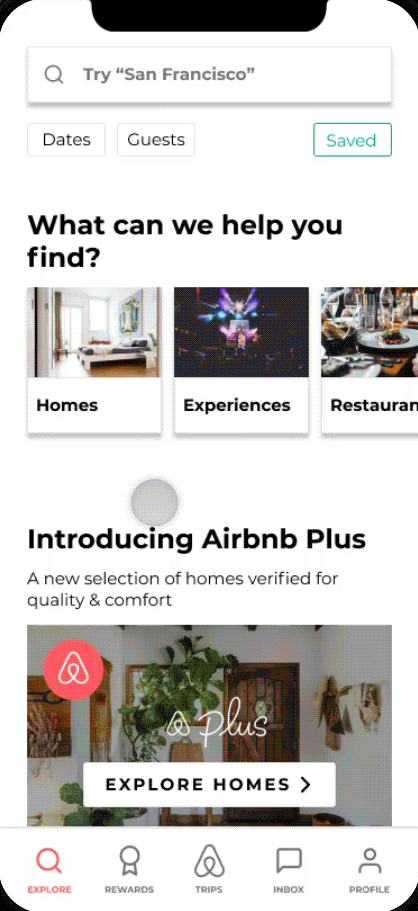The Opportunity
One of Airbnb’s biggest advantages over competitors is their platform’s ability to connect travellers with unique accommodations that allow travellers to experience more local, authentic ways of living. While the platform currently incentivizes hosts to create the best accommodations with recognition of being a "Superhost"— if they accummulate enough good, consistent reviews—my team member and I wondered if there was also an opportunity to incentivize new and loyal customers to book with Airbnb.
With hotels offering customers travel deals and vacation packages as incentives to book with them, as well as apartment-style homes to stay competitive with sharing economy accommodations, we wanted to explore ways in which Airbnb could stay competitive in acquiring new customers and retaining their existing customer base.
How can Airbnb stay competitive in acquiring new customers and retain their existing customer base?
Understanding the market
To gain a better understanding of Airbnb’s strengths, weaknesses, and how they stacked up against their competitors, we conducted a competitive analysis of general app features on Airbnb and popular hotel chains.

Key Insights
- All hotels had a rewards program in place
- Hotels offered customers multiple avenues in which they could earn and apply their points
Solution
Introduce a rewards program
Our solution was to implement a points-based rewards program on Airbnb’s platform that allows customers to collect and use their points towards purchases on Airbnb Homes, Experiences, and Restaurants. We believed this would increase customer engagement and retention on their platform, while also encourage customers to use other services offered by Airbnb, specifically their Experiences and Restaurants.
Why a rewards program?
Reward programs are a cost-effective way for companies to give back to their customers, while encouraging more user engagement and long-term brand loyalty. Hotels chains like Hilton and Marriott currently have reward programs in place as a motivating factor for customers to re-book with them. This is something that Airbnb has considered, but not yet implemented.
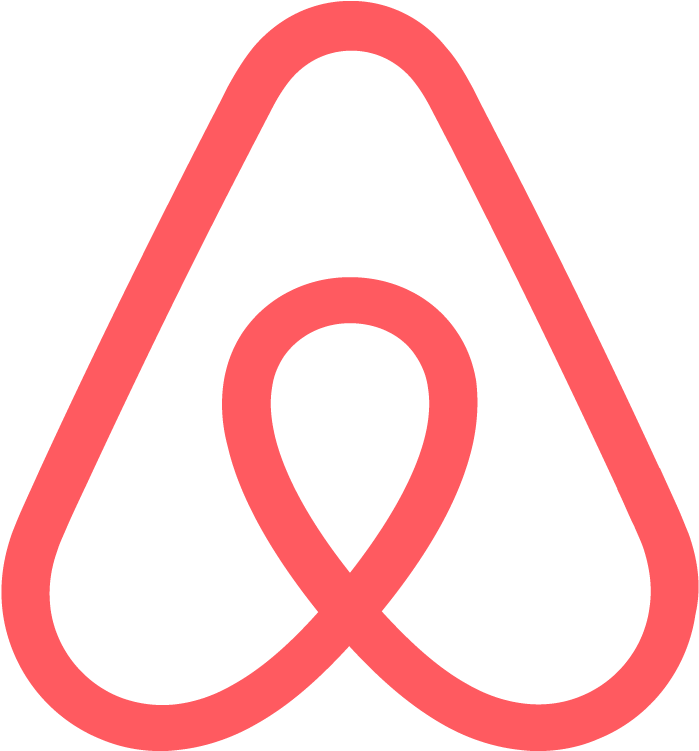
A rewards program with Airbnb called Superguests was highly anticipated by loyal customers. However, after researching and putting together a pilot, Airbnb’s President of Homes stated it didn’t have enough community involvement for them to launch it. (source)
The Approach
User interviews
To get a better understanding of potential users, we decided to conduct user interviews and chose a target demographic we thought would benefit most from a rewards program—young adults between the ages of 18 - 30. Because we didn't have insight into Airbnb's customer base, we made the assumption that individuals around this age range were more likely to be either students or early working professionals, and their goals may align more with optimizing their travels on a budget. My partner and I each interviewed 5 users from this demographic on their likes, motivations, attitudes, and pain points towards Airbnb and rewards programs.
Affinity Mapping
After compiling data from user interviews, we created an affinity map on users’ likes, habits, motivations, and pain points to find any patterns or connections between the information we collected. This helped us organize our information and develop our persona.

Key Insights
- Hotels were preferred over Airbnbs when pricing was the same, because of reliability
- Many users had heard about Airbnb’s Experiences and Restaurants features but hadn’t used them
- Saving money was a big reason why users joined reward programs, while limited reward options was a pain point
Personas
From our affinity diagram, we created a persona of our primary user that would benefit from a rewards program on Airbnb. This helped us to visualize and understand what our potential user’s goals, motivations, personality, and pain points might be.
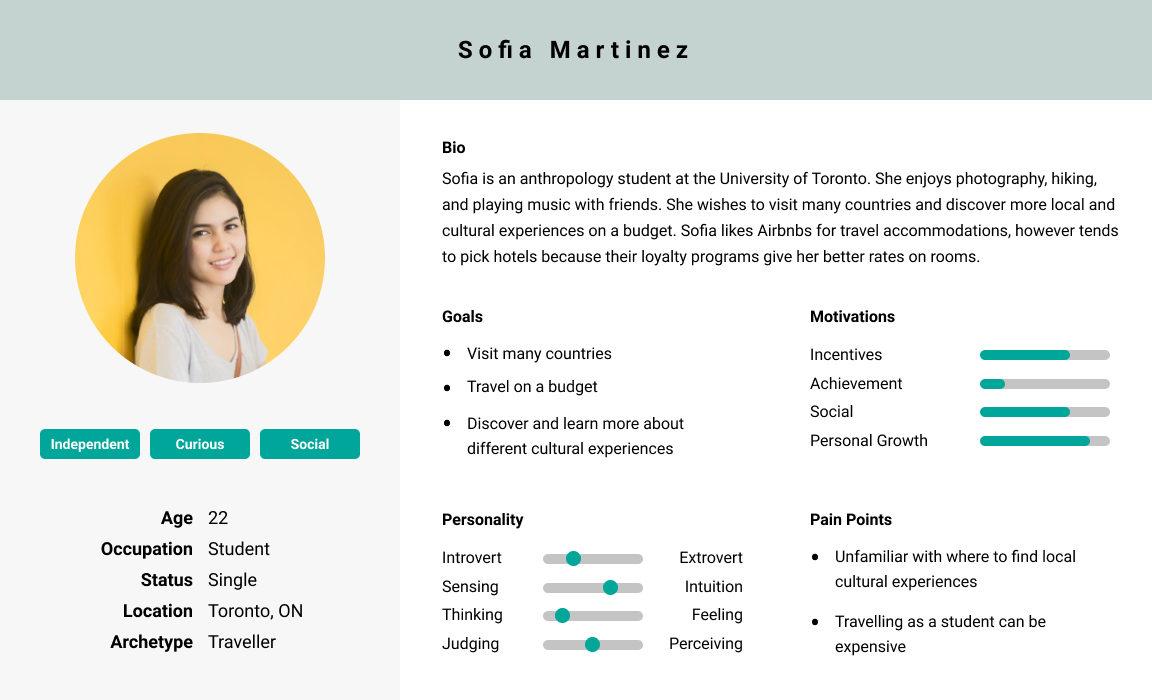
Sofia Martinez is a young, budget-conscious student who wishes to visit many countries to learn and immerse herself in different cultural experiences. She is looking for experiences that are different and unique, and would love to be able to discover and book experiences more easily, as she prefers not to book with expensive tours. Her biggest motivation to travel is for personal growth, and her biggest pain point is how expensive travelling is.
User Flow
Once we had an idea of potential goals and motivations for using a rewards program, we outlined the main task users would accomplish with the integration of the rewards program: To view and redeem their points towards an Experience. This helped to provide clearer direction and understanding of the steps users would take to complete the task, as well as more structure to our sketches later on.

Wireframes
From our user flow, I created initial designs of the main task to better visualize the layout. The main changes we made to Airbnb’s current interface were:
- Rewards Page — A new informational page showing users how many points they currently have
- Checkout Page — A modified page where users have the option to pay for an Experience using their points
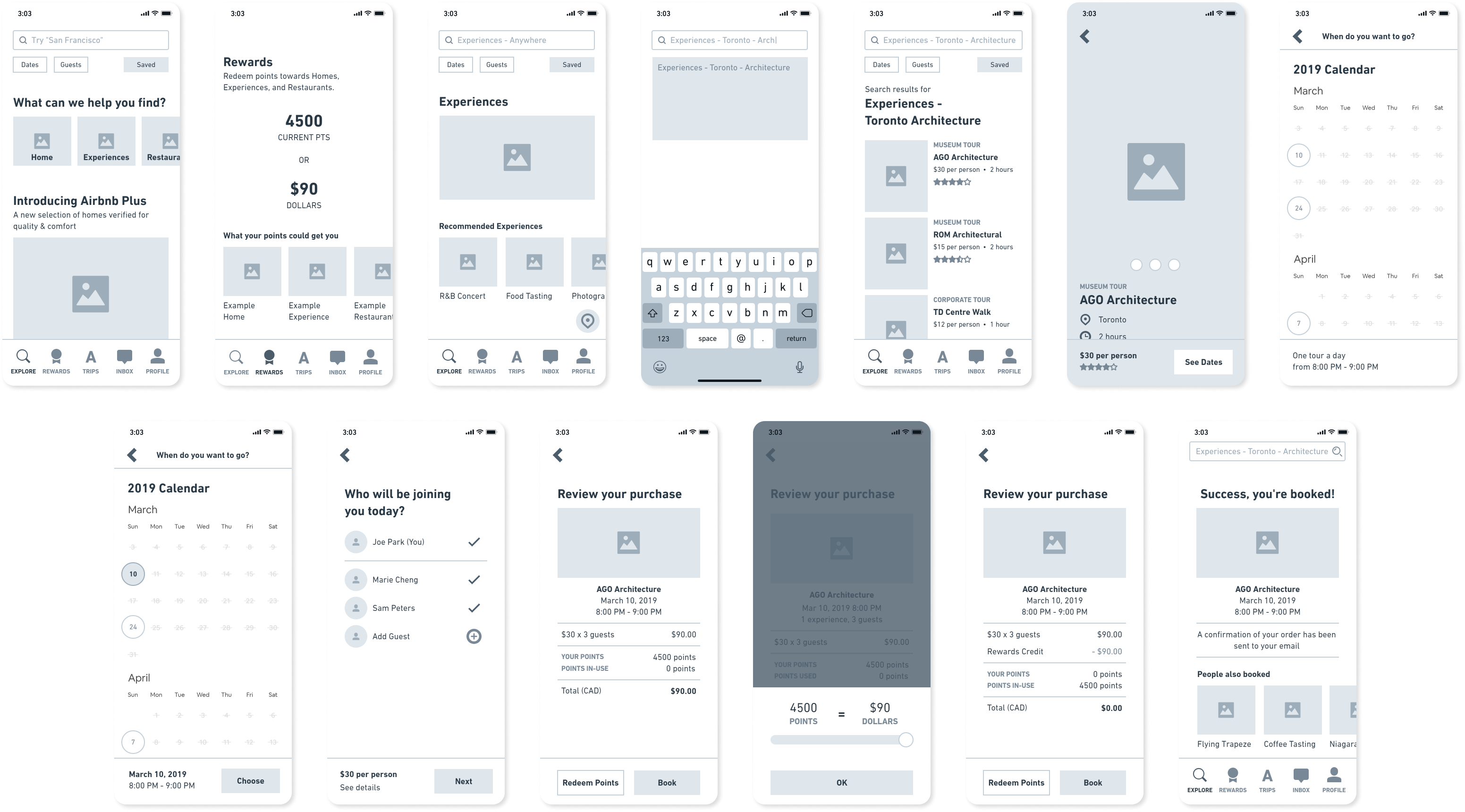
Key Design Decisions
- Swap Saved with Rewards in the navigation bar — to increase discoverability and engagement of the new Rewards page
- Move Saved to Home/Explore page — to keep it easily accessible for users while they browse Homes, Experiences, and Restaurants.
Mockups
I recreated Airbnb’s established style guide in Figma to make the design process more clear and efficient when creating the high-fidelity mockups. As Airbnb uses a customized sans-serif font (Airbnb Cereal) that we did not have access to, we decided to use a similar alternative.


Usability Testing
To validate the designs and get feedback on the approach, we conducted usability tests with a total of 5 users. While they completed the task, I took note of what actions they did or did not take to accomplish the goal, and followed up at the end with questions on their thought process, reasonings, and overall experience.
View and redeem points towards the AGO Architecture Tour Experience
Key Insights
- Majority of users found the task relatively easy to complete
- Some users wanted to know what the standard conversion rate was for earning points
- Users wanted to be able to view their reward point history (during second usability test)
Iterations
Rewards page (Iteration 1)
- Progress Bar — visually shows how far a user is from their next goal.
- Learn More Button — show more information on Airbnb Rewards, including conversion rate of points to dollar value.
- Explore Airbnb button — redirect users back to the Home/Explore page. Having a quick redirect button on the Rewards page may motivate users to spend or browse Airbnb’s Homes, Experiences, and Restaurants, especially after viewing their progress towards their next goal.

Rewards page (Iteration 2)
- History Button — allows users to view their reward point history.
- Made Learn More button accessible from the progress bar (indicating with “ › ”) — more descriptive wording for the progress bar and adding a right arrow imply that there is more information users can view on rewards.
- Carousal (Point/Credit balance) — users can swipe to switch between their points and equated credit balance. Credit balance is hidden from immediate view on the Rewards page. This emphasizes the gamification aspect of the program, and motivates users to collect points as points would be inflated more than the dollar amount.
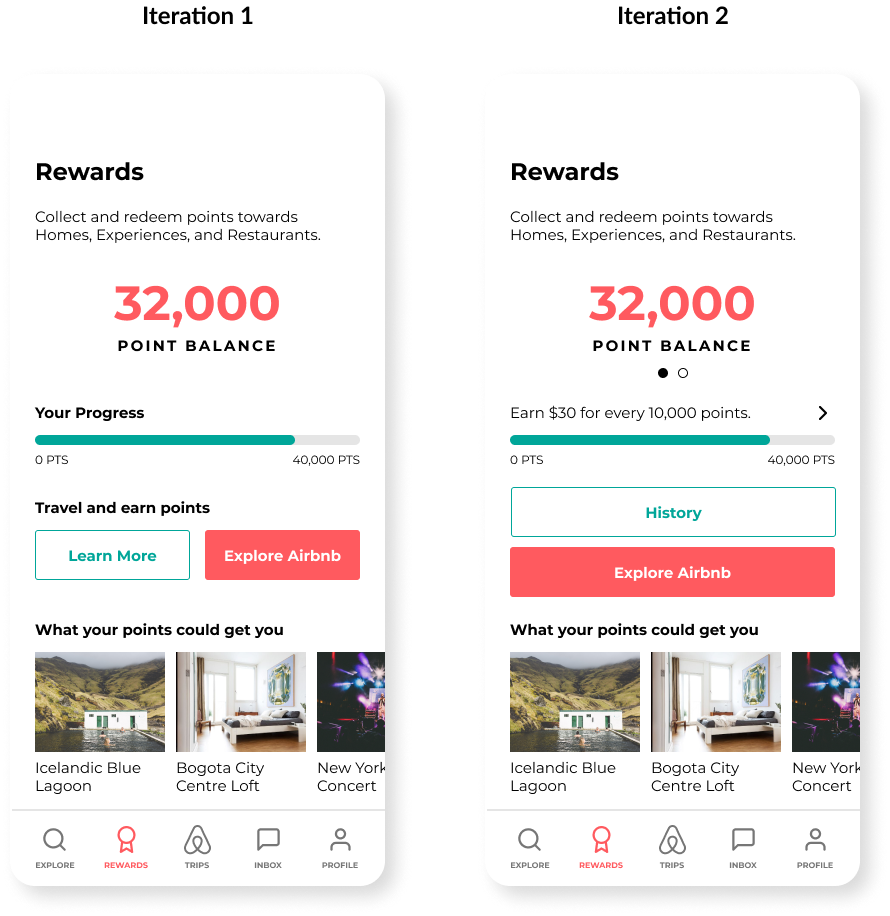
Prototype
